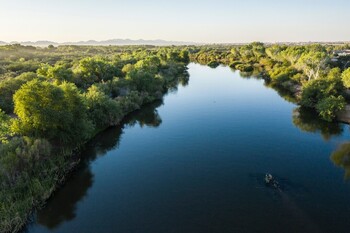News
Back to News
Congressional legislation ensures long-term stability for Yuma Crossing
Legislation approved by the U.S. Congress ensures the long-term stability of the Yuma Crossing National Heritage Area.
On Thursday, the House of Representatives approved the National Heritage Area Act (S. 1942) with a bipartisan vote of 326-95.
This action followed the unusual vote of “unanimous consent” by the Senate requiring no objections from any of the 100 senators.
This legislation will replace a patchwork of individual funding authorizations with a program that creates clear criteria for designation and accountability, fiscal stability through a 15-year renewal of the program and a commitment to protect private property rights.
Congressional legislation ensures long-term stability for Yuma Crossing
Legislation approved by the U.S. Congress ensures the long-term stability of the Yuma Crossing National Heritage Area.
On Thursday, the House of Representatives approved the National Heritage Area Act (S. 1942) with a bipartisan vote of 326-95.
This action followed the unusual vote of “unanimous consent” by the Senate requiring no objections from any of the 100 senators.
This legislation will replace a patchwork of individual funding authorizations with a program that creates clear criteria for designation and accountability, fiscal stability through a 15-year renewal of the program and a commitment to protect private property rights.
An additional seven National Heritage Areas were authorized, a reflection of the popularity of the concept, YCNHA said in a press release.
The annual investment of $29 million through the National Park Service yields an additional $5.50 of local, state and private funding for every federal dollar, according to the press release.
“The Heritage Area now has a solid long-term financial foundation to continue our work to improve Yuma’s riverfront, to manage Yuma’s State Historic Parks, and to restore, preserve, and interpret Yuma’s rich history,” said Cathy Douglas, executive director of the YCNHA.
According to National Park Service studies, the Yuma Crossing contributes about $22.7 million to the Arizona economy through tourism and outdoor recreation opportunities.
Yuma’s NHA is funded primarily through donations from local and tribal governments and private individuals, and only one-fifth of its budget is funded by the Park Service, according to a 2015 NPS review of the YCNHA.
The 55 National Heritage Areas around the country are grassroots organizations that promote economic development through historic preservation and natural resource conservation.
The Yuma Crossing National Heritage Area encompasses seven square miles along the Colorado River in Yuma and Winterhaven, California. It includes the Yuma Crossing National Historic Landmark and the Yuma Territorial Prison and Colorado River state historic parks, Fort Yuma, and more than three miles of contiguous riverfront parks, trails and 400 acres of restored wetlands.
This legislation was championed by Congressman Paul Tonko (D-NY) and Congressman David McKinley (R-WV) in the House and Senator Debbie Stabenow (D-MI) and Senator Roy Blunt (R-MO) in the Senate.
Arizona Congressman Raul Grijalva, who is chairman of the House Committee on Natural Resources, played a crucial role in shepherding the legislation through the House of Representatives.
Arizona Senators Mark Kelly and Kristen Sinema helped secure the unanimous vote in the Senate.
Shelley Mellon, chairperson of the Yuma Crossing National Heritage Area, said: “We thank all our partners, particularly our Arizona advocates, who helped secure this important legislation. We also thank the Yuma community who recently voted to extend the 2% hospitality tax. These are both great victories for Yuma.”
Sara Capen, who leads the Alliance of National Heritage Areas, commented: “The National Heritage Area Act is a testament to the tremendous work National Heritage Areas do within communities across America. It is a direct reflection of the determination and resilience that is not only the bedrock of National Heritage Areas, but also the history of the places and people National Heritage Areas represent.
“The Alliance of National Heritage Areas is profoundly grateful for the tireless leadership and support we have received on a bipartisan basis within Congress today and look forward to serving our communities for an additional 15 years,” she added.
The legislation becomes law with the signature of President Biden


